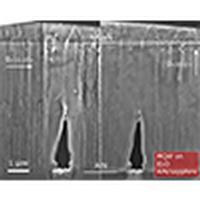当前位置:
X-MOL 学术
›
Photonics Res.
›
论文详情
Our official English website, www.x-mol.net, welcomes your feedback! (Note: you will need to create a separate account there.)
Improved performance of UVC-LEDs by combination of high temperature annealing and epitaxially laterally overgrown AlN/sapphire
Photonics Research ( IF 7.6 ) Pub Date : 2020-04-01 , DOI: 10.1364/prj.385275 Norman Susilo , Eviathar Ziffer , Sylvia Hagedorn , Leonardo Cancellara , Carsten Netzel , Neysha Lobo Ploch , Shaojun Wu , Jens Rass , Sebastian Walde , Luca Sulmoni , Martin Guttmann , Tim Wernicke , Martin Albrecht , Markus Weyers , Michael Kneissl
Photonics Research ( IF 7.6 ) Pub Date : 2020-04-01 , DOI: 10.1364/prj.385275 Norman Susilo , Eviathar Ziffer , Sylvia Hagedorn , Leonardo Cancellara , Carsten Netzel , Neysha Lobo Ploch , Shaojun Wu , Jens Rass , Sebastian Walde , Luca Sulmoni , Martin Guttmann , Tim Wernicke , Martin Albrecht , Markus Weyers , Michael Kneissl

|
We report on the performance of AlGaN-based deep ultraviolet light-emitting diodes (UV-LEDs) emitting at 265 nm grown on stripe-patterned high-temperature annealed (HTA) epitaxially laterally overgrown (ELO) aluminium nitride (AlN)/sapphire templates. For this purpose, the structural and electro-optical properties of ultraviolet-c light-emitting diodes (UVC-LEDs) on as-grown and on HTA planar AlN/sapphire as well as ELO AlN/sapphire with and without HTA are investigated and compared. Cathodoluminescence measurements reveal dark spot densities of 3.5×109 cm−2, 1.1×109 cm−2, 1.4×109 cm−2, and 0.9×109 cm−2 in multiple quantum well samples on as-grown planar AlN/sapphire, HTA planar AlN/sapphire, ELO AlN/sapphire, and HTA ELO AlN/sapphire, respectively, and are consistent with the threading dislocation densities determined by transmission electron microscopy (TEM) and high-resolution X-ray diffraction rocking curve. The UVC-LED performance improves with the reduction of the threading dislocation densities (TDDs). The output powers (measured on-wafer in cw operation at 20 mA) of the UV-LEDs emitting at 265 nm were 0.03 mW (planar AlN/sapphire), 0.8 mW (planar HTA AlN/sapphire), 0.9 mW (ELO AlN/sapphire), and 1.1 mW (HTA ELO AlN/sapphire), respectively. Furthermore, Monte Carlo ray-tracing simulations showed a 15% increase in light-extraction efficiency due to the voids formed in the ELO process. These results demonstrate that HTA ELO AlN/sapphire templates provide a viable approach to increase the efficiency of UV-LEDs, improving both the internal quantum efficiency and the light-extraction efficiency.
中文翻译:

通过结合高温退火和外延横向过度生长的 AlN/蓝宝石提高 UVC-LED 的性能
我们报告了在条纹图案高温退火 (HTA) 外延横向过度生长 (ELO) 氮化铝 (AlN)/蓝宝石模板上生长的基于 AlGaN 的深紫外发光二极管 (UV-LED) 的性能. 为此,研究并比较了生长状态和 HTA 平面 AlN/蓝宝石以及 ELO AlN/蓝宝石上的紫外-c 发光二极管 (UVC-LED) 的结构和电光特性. 阴极发光测量显示,在生长的平面 AlN/蓝宝石、HTA 上的多个量子阱样品中,暗点密度为 3.5×109 cm-2、1.1×109 cm-2、1.4×109 cm-2 和 0.9×109 cm-2分别为平面 AlN/sapphire、ELO AlN/sapphire 和 HTA ELO AlN/sapphire,并且与透射电子显微镜 (TEM) 和高分辨率 X 射线衍射摇摆曲线确定的螺纹位错密度一致。UVC-LED 性能随着穿透位错密度 (TDD) 的降低而提高。以 265 nm 发射的 UV-LED 的输出功率(在 20 mA 的连续工作中在晶圆上测量)为 0.03 mW(平面 AlN/蓝宝石)、0.8 mW(平面 HTA AlN/蓝宝石)、0.9 mW(ELO AlN/蓝宝石)蓝宝石)和 1.1 mW(HTA ELO AlN/蓝宝石)。此外,蒙特卡罗光线追踪模拟表明,由于 ELO 工艺中形成的空隙,光提取效率提高了 15%。这些结果表明 HTA ELO AlN/蓝宝石模板提供了一种提高 UV-LED 效率的可行方法,
更新日期:2020-04-01
中文翻译:

通过结合高温退火和外延横向过度生长的 AlN/蓝宝石提高 UVC-LED 的性能
我们报告了在条纹图案高温退火 (HTA) 外延横向过度生长 (ELO) 氮化铝 (AlN)/蓝宝石模板上生长的基于 AlGaN 的深紫外发光二极管 (UV-LED) 的性能. 为此,研究并比较了生长状态和 HTA 平面 AlN/蓝宝石以及 ELO AlN/蓝宝石上的紫外-c 发光二极管 (UVC-LED) 的结构和电光特性. 阴极发光测量显示,在生长的平面 AlN/蓝宝石、HTA 上的多个量子阱样品中,暗点密度为 3.5×109 cm-2、1.1×109 cm-2、1.4×109 cm-2 和 0.9×109 cm-2分别为平面 AlN/sapphire、ELO AlN/sapphire 和 HTA ELO AlN/sapphire,并且与透射电子显微镜 (TEM) 和高分辨率 X 射线衍射摇摆曲线确定的螺纹位错密度一致。UVC-LED 性能随着穿透位错密度 (TDD) 的降低而提高。以 265 nm 发射的 UV-LED 的输出功率(在 20 mA 的连续工作中在晶圆上测量)为 0.03 mW(平面 AlN/蓝宝石)、0.8 mW(平面 HTA AlN/蓝宝石)、0.9 mW(ELO AlN/蓝宝石)蓝宝石)和 1.1 mW(HTA ELO AlN/蓝宝石)。此外,蒙特卡罗光线追踪模拟表明,由于 ELO 工艺中形成的空隙,光提取效率提高了 15%。这些结果表明 HTA ELO AlN/蓝宝石模板提供了一种提高 UV-LED 效率的可行方法,



























 京公网安备 11010802027423号
京公网安备 11010802027423号